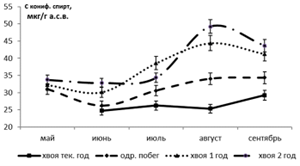DYNAMICS OF THE FORMATION OF THE PHENOLIC REDOX SYSTEM OF CONIFEROUS PLANTS ON THE EXAMPLE OF THE COMMON PINE PINUS SYLVESTRIS
UDC 582.475, 54.061, 543.2
Abstract
The change in the quantitative composition of secondary metabolites in the forming plant tissue is associated with climatic conditions of plant growth, including seasonality and the growing season. Acclimatization of evergreen coniferous trees in boreal regions includes regulatory processes that protect the photosynthetic apparatus of needles in specific conditions. Using the example of coniferous tree – scots pine (Pinus sylvestris), new experimental data on changes in the content of secondary metabolites of phenolic nature – participants in the processes of plant tissue biosynthesis – is presented in this paper. The dynamics of the intensity of phenolic metabolism and the quantitative change of the pigment apparatus of pine needles during the growing season were investigated using a complex of physic-chemical methods (UV spectrophotometry, HPLC, redox-metry) and the composition of the phenolic fraction of the phenol-quinone redox system of the cell wall was studied. It is shown that changes in the quantitative and qualitative composition of the phenolic compounds fraction that determine the redox state of the plant matrix occurs in plant tissue throughout the growing season. It is noted that dynamic self-regulation processes involving a complex consisting of phenolic compounds, pigments and enzymatic systems are a common pattern at all stages of plant development, ensuring that they perform protective functions of the photosynthetic apparatus of the needles of evergreen coniferous trees in boreal regions.
Downloads
Metrics
References
Fang X., Yang C-Q., Wei Y-K., Ma Q.X., Yang L., Chen X.-Y. Plant Diversity and Resources, 2011, vol. 33, pp. 53–64. DOI: 10.3724/SP.J.1143.2011.10233.
Ramakrishna A., Ravishankar G.A. Plant Signaling and Behavior, 2011, vol. 6, pp. 1720–1731. DOI: 10.4161/psb.6.11.17613.
Achakzai K.K.A., Achakzai P., Masood A., Kayani S.A., Tareen R.B. Pakistan Journal of Botany, 2009, vol. 41, pp. 2129–2135.
Zaprometov M.N. Fenol'nyye soyedineniya: rasprostraneniye, metabolizm i funktsii v rasteniyakh. [Phenolic com-pounds: distribution, metabolism and functions in plants]. Moscow, 1993, 272 p. (in Russ.).
De Meester B., Vanholme R., Mota T., Boerjan W. Plant Communications, 2022, vol. 3, article 100465. DOI: 10.1016/j.xplc.2022.100465.
Gusakova M.A., Bogolitsyn K.G., Krasikova A.A., Selivanova N.V., Khviyuzov S.S. Khimiya rastitel'nogo syr'ya, 2022, no. 1, pp. 213–223. DOI: 10.14258/jcprm.2022019685.
Kumar A., Singhal K.C., Sharma R.A., Vyas G.K., Kumar V. Asian Journal of Experimental Biological Sciences, 2013, vol. 4, pp. 155–158.
Darwish R.S., Hammoda H.M., Ghareeb D.A., Abdelhamid A.S.A., Harraz F.M., Shawky E. RSC Advances, 2021, vol. 11, pp. 24624–24635. DOI: 10.1039/d1ra01681d.
Plaksina I.V. Khimiya rastitel'nogo syr'ya, 2009, no. 1, pp. 103–105. (in Russ.).
Gallet C., Pellissier F. Journal of Chemical Ecology, 1997, vol. 23, pp. 2401–2412.
Muscolo A., Sidari M. Plant and Soil, 2006, vol. 284, pp. 305–318.
Ladanova N.V., Plyusnina S.N. Lesnoy zhurnal, 1998, no. 1, pp. 7–11. (in Russ.).
Nikolayeva T.N., Lapshin P.V., Zagoskina N.V. Khimiya rastitel'nogo syr'ya, 2021, no. 2, pp. 291–299. DOI: 10.14258/jcprm.2021028250. (in Russ.).
Bogolitsyn K.G., Surso M.V., Gusakova M.A., Zubov I.N. IVUZ. Lesnoy zhurnal, 2013, no. 6, pp. 91–96. (in Russ.).
Shlyk A.A. Biokhimicheskiye metody v fiziologii rasteniy. [Biochemical methods in plant physiology]. Moscow, 1971, pp. 154–170. (in Russ.).
Katerova Z., Todorova D., Sergiev I. Medicinal Plants and Environmental Challenges. Cham, Springer, 2017, pp. 97–121. DOI: 10.1007/978-3-319-68717-9_6.
Bag P., Chukhutsina V., Zhang Z., Paul S., Ivanov A.G., Shutova T., Croce R., Holzwarth A.R., Jansson S. Nature Communications, 2020, vol. 11, article 6388. DOI: 10.1038/s41467-020-20137-9.
Gusakova M.A., Bogolitsyn K.G., Krasikova A.A., Selivanova N.V., Khviyuzov S.S., Samsonova N.A. Lesnoy zhur-nal, 2022, no. 1, pp. 36–46. DOI: 10.37482/0536-1036-2022-1-36-48. (in Russ.).
Tuzhilkina V.V. Sibirskiy lesnoy zhurnal, 2017, no. 1, pp. 65–73. (in Russ.).
Shavnin S.A., Yusupov I.A., Marina N.V., Montile A.A., Golikov D.Yu. Fiziologiya rasteniy, 2021, vol. 68, no. 2, pp. 1–11. DOI: 10.31857/S0015330321020184. (in Russ.).
Öguist G., Huner N.P.A. Annual Review of Plant Biology, 2003, vol. 54, pp. 329–355. DOI: 10.1146/annurev.arplant.54.072402.115741.
Sofronova V.E., Dymova O.V., Golovko T.K., Chepalov V.A., Petrov K.A. Russian Journal of Plant Physiology, 2016, vol. 63, pp. 433–442. DOI: 10.1134/S1021443716040142.
Gricar J., Cufar K., Eler K., Gryc V., Vavrčík H., De Luis M., Prislan P. Forests, 2021, vol. 12, article 331. DOI: 10.3390/f12030331.
Cartenì F., Deslauriers A., Rossi S., Morin H., De Micco V., Mazzoleni S., Giannino F. Frontiers in Plant Science, 2018, vol. 9, article 1053. DOI: 10.3389/fpls.2018.01053.

Copyright (c) 2023 chemistry of plant raw material

This work is licensed under a Creative Commons Attribution 4.0 International License.

This work is licensed under a Creative Commons Attribution 4.0 International License.
The authors, which are published in this journal, agree to the following conditions:
1. Authors retain the copyright to the work and transfer to the journal the right of the first publication along with the work, at the same time licensing it under the terms of the Creative Commons Attribution License, which allows others to distribute this work with the obligatory indication of the authorship of this work and a link to the original publication in this journal .
2. The authors retain the right to enter into separate, additional contractual agreements for the non-exclusive distribution of the version of the work published by this journal (for example, to place it in the university depository or to publish it in a book), with reference to the original publication in this journal.
3. Authors are allowed to post their work on the Internet (for example, in a university repository or on their personal website) before and during the review process of this journal, as this may lead to a productive discussion, as well as more links to this published work.











